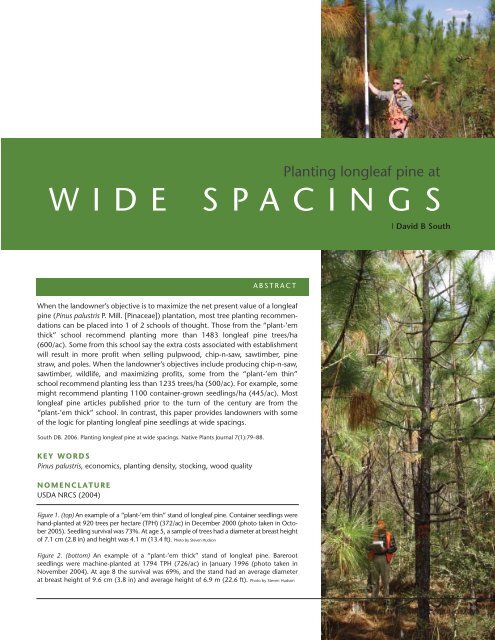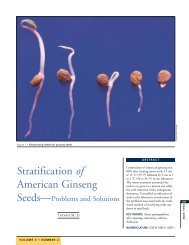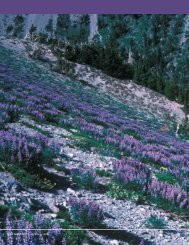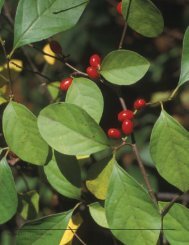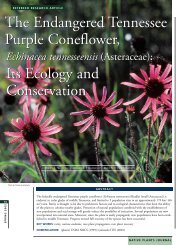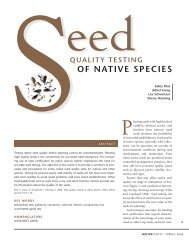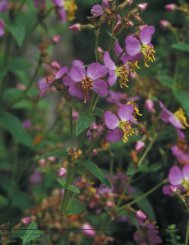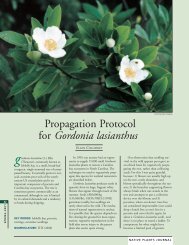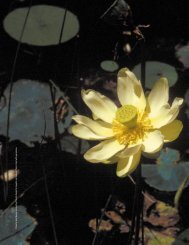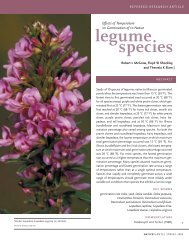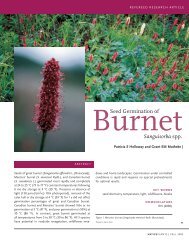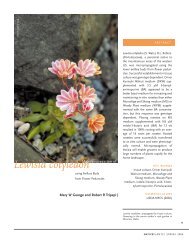Planting longleaf pine at Wide Spacings
Planting longleaf pine at Wide Spacings
Planting longleaf pine at Wide Spacings
You also want an ePaper? Increase the reach of your titles
YUMPU automatically turns print PDFs into web optimized ePapers that Google loves.
<strong>Planting</strong> <strong>longleaf</strong> <strong>pine</strong> <strong>at</strong><br />
WIDE SPACINGS<br />
| David B South<br />
ABSTRACT<br />
When the landowner’s objective is to maximize the net present value of a <strong>longleaf</strong><br />
<strong>pine</strong> (Pinus palustris P. Mill. [Pinaceae]) plant<strong>at</strong>ion, most tree planting recommend<strong>at</strong>ions<br />
can be placed into 1 of 2 schools of thought. Those from the “plant-’em<br />
thick” school recommend planting more than 1483 <strong>longleaf</strong> <strong>pine</strong> trees/ha<br />
(600/ac). Some from this school say the extra costs associ<strong>at</strong>ed with establishment<br />
will result in more profit when selling pulpwood, chip-n-saw, sawtimber, <strong>pine</strong><br />
straw, and poles. When the landowner’s objectives include producing chip-n-saw,<br />
sawtimber, wildlife, and maximizing profits, some from the “plant-’em thin”<br />
school recommend planting less than 1235 trees/ha (500/ac). For example, some<br />
might recommend planting 1100 container-grown seedlings/ha (445/ac). Most<br />
<strong>longleaf</strong> <strong>pine</strong> articles published prior to the turn of the century are from the<br />
“plant-’em thick” school. In contrast, this paper provides landowners with some<br />
of the logic for planting <strong>longleaf</strong> <strong>pine</strong> seedlings <strong>at</strong> wide spacings.<br />
South DB. 2006. <strong>Planting</strong> <strong>longleaf</strong> <strong>pine</strong> <strong>at</strong> wide spacings. N<strong>at</strong>ive Plants Journal 7(1):79–88.<br />
K E Y W O R D S<br />
Pinus palustris, economics, planting density, stocking, wood quality<br />
N O M E N C L A T U R E<br />
USDA NRCS (2004)<br />
Figure 1. (top) An example of a “plant-’em thin” stand of <strong>longleaf</strong> <strong>pine</strong>. Container seedlings were<br />
hand-planted <strong>at</strong> 920 trees per hectare (TPH) (372/ac) in December 2000 (photo taken in October<br />
2005). Seedling survival was 73%. At age 5, a sample of trees had a diameter <strong>at</strong> breast height<br />
of 7.1 cm (2.8 in) and height was 4.1 m (13.4 ft). Photo by Steven Hudson<br />
Figure 2. (bottom) An example of a “plant-’em thick” stand of <strong>longleaf</strong> <strong>pine</strong>. Bareroot<br />
seedlings were machine-planted <strong>at</strong> 1794 TPH (726/ac) in January 1996 (photo taken in<br />
November 2004). At age 8 the survival was 69%, and the stand had an average diameter<br />
<strong>at</strong> breast height of 9.6 cm (3.8 in) and average height of 6.9 m (22.6 ft). Photo by Steven Hudson<br />
79<br />
NATIVE PLANTS | SPRING 2006
80<br />
The spacing of planted <strong>longleaf</strong><br />
<strong>pine</strong> (Pinus palustris P. Mill.<br />
[Pinaceae]) seedlings affects<br />
not only the growth and development<br />
of the stand but also the economic<br />
returns. Wahlenberg (1946) wrote th<strong>at</strong><br />
“the spacing of trees in plant<strong>at</strong>ions<br />
depends on the survival expected and on<br />
economic consider<strong>at</strong>ions, such as costs of<br />
establishment, major products, market for<br />
thinnings, and effects of stand density and<br />
crown differenti<strong>at</strong>ion on n<strong>at</strong>ural pruning<br />
of the stems. The tendency has been to<br />
space too widely.” He said th<strong>at</strong> 2988 trees<br />
per hectare (TPH) (1210/ac) were generally<br />
recommended, and th<strong>at</strong> 3556 TPH<br />
(1440/ac) were “considered advisable<br />
where pulpwood thinnings can be made.”<br />
If the stand was not going to be thinned<br />
and was planted for timber production, he<br />
recommended 1680 to 2241 TPH (680 to<br />
907/ac). In contrast, for naval stores he suggested<br />
747 or 1076 TPH (303 or 434/ac).<br />
Over the years, the recommended<br />
planting density for <strong>longleaf</strong> <strong>pine</strong><br />
seedlings has decreased. At the beginning<br />
of the 20th century in Europe, the<br />
number of trees outplanted varied<br />
between 2471 and 98 840 TPH (1000 to<br />
40 000/ac) (Schenck 1907). Some foresters<br />
recommended planting 2965 <strong>longleaf</strong><br />
<strong>pine</strong> seedlings per ha (1200/ac) (Ware<br />
and Stahelin 1948; Wakeley 1954; Dennington<br />
and Farrar 1983), while others<br />
(Muntz 1954; Hamilton 1956) recommended<br />
higher stocking because of historically<br />
low seedling survival. As<br />
seedling quality improved, recommended<br />
planting r<strong>at</strong>es fell, and by the end<br />
of the 20th century some were planting<br />
less than 1557 TPH (630/ac) (Sasnett and<br />
others 1990; Sirmon 1990). Currently,<br />
most managers of <strong>longleaf</strong> <strong>pine</strong> want to<br />
manage for wildlife and (or) sawtimber<br />
and target a stocking level of 494 to 1483<br />
TPH (200 to 600/ac) (Boyette 1996).<br />
Today, there are 2 schools of thought<br />
regarding the number of <strong>longleaf</strong> <strong>pine</strong><br />
seedlings th<strong>at</strong> should be planted when<br />
the landowner’s main objectives are to<br />
increase the net present value of the<br />
stand and to manage for wildlife. Some<br />
say these objectives will be met by planting<br />
seedlings “thin” (Figure 1), while others<br />
recommend seedlings be planted close<br />
together (Figure 2). Those from the<br />
“plant-’em thick” school might recommend<br />
planting 1483 to 3556 TPH (600 to<br />
1440/ac), whereas the “plant-’em thin”<br />
school might recommend 740 to 1235<br />
TPH (300 to 500/ac) (Franklin 1997).<br />
SAWTIMBER PRODUCTION<br />
When stands are not thinned, sawtimber<br />
production <strong>at</strong> a given age will be rel<strong>at</strong>ed to<br />
the number of trees planted. For example,<br />
2 <strong>longleaf</strong> <strong>pine</strong> growth and yield models<br />
(WinYield [Hepp 1996] and SiMS03<br />
[ForesTech 2005]) indic<strong>at</strong>e th<strong>at</strong> planting<br />
625 to 1111 TPH (253 to 450/ac) will produce<br />
more sawtimber <strong>at</strong> age 30 than planting<br />
1600 to 2066 TPH (648 to 836/ac).<br />
This is because the higher stocking r<strong>at</strong>es<br />
will delay the time required for trees to<br />
reach a sawtimber diameter <strong>at</strong> breast<br />
height (DBH). For example, on some sites,<br />
it may take 14 additional years for a stand<br />
planted <strong>at</strong> 2066 TPH (836/ac) to achieve<br />
the same amount of sawlogs as a 625 TPH<br />
(253/ac) stand (Figure 3). Even when<br />
stands are commercially thinned, a stand<br />
with 292 TPH (118/ac <strong>at</strong> harvest age 39)<br />
might provide more sawtimber and pole<br />
volume than a stand with 1030 TPH<br />
(417/ac) <strong>at</strong> harvest (Kush and others 1998).<br />
PINE STRAW PRODUCTION<br />
Pine straw is a popular mulch with<br />
homeowners and landscapers. The<br />
demand for this mulch has been high<br />
and the returns from <strong>pine</strong> straw production<br />
are gre<strong>at</strong>er than those obtained<br />
from intermedi<strong>at</strong>e pulpwood thinnings.<br />
Some landowners might expect a net<br />
profit of US$ 200 to $300 per ha ($81 to<br />
$121/ac) every other year (Pickens<br />
2005). When <strong>pine</strong> straw production is<br />
the primary objective, then stands with<br />
basal areas of 23+ m 2 /ha (100+ ft 2 /ac)<br />
will result in more <strong>pine</strong> straw production<br />
than stands with 11 m 2 /ha (48 ft 2 /ac) or<br />
less (Rayamajhi and Kush 2001).<br />
Spacing will affect the time required<br />
for a plant<strong>at</strong>ion to reach a basal area of<br />
23 m 2 /ha. According to one growth and<br />
yield program (SiMS03), planting 741<br />
TPH (300/ac) on good sites will take<br />
approxim<strong>at</strong>ely 4 additional years to<br />
reach a basal area of 23 m 2 /ha as compared<br />
with 1977 TPH (800/ac). Therefore,<br />
those who wish to plant <strong>longleaf</strong><br />
<strong>pine</strong> on wide spacings should realize<br />
th<strong>at</strong> <strong>pine</strong> straw production will be<br />
delayed for several years.<br />
POLE PRODUCTION<br />
The production of poles is of interest to<br />
many landowners because the stumpage<br />
value might be US$ 27/Mg ($24.50/ton)<br />
gre<strong>at</strong>er than for sawtimber. Therefore,<br />
some recommend rel<strong>at</strong>ively long rot<strong>at</strong>ions,<br />
rel<strong>at</strong>ively dense stands, and multiple<br />
thinnings to produce a high<br />
percentage of straight poles (approxim<strong>at</strong>ely<br />
1/100 cm (1/100 in) from butt to<br />
tip of pole). In most n<strong>at</strong>urally regener<strong>at</strong>ed<br />
stands, the production of poles is<br />
gre<strong>at</strong>est <strong>at</strong> ages of 50 to 60 y (Williston<br />
and others 1990). Because it takes a 25-<br />
m (82-ft) tree to make a 24-m (78-ft)<br />
pole, only a few trees will make poles by<br />
age 25 y. In one 46-y-old stand, the volume<br />
of poles was about the same from<br />
14 to 28 m 2 /ha (61 to 122 ft 2 /ac) of basal<br />
area. In general, larger diameter poles<br />
are produced <strong>at</strong> 14 m 2 /ha whereas more,<br />
smaller-diameter poles were produced<br />
<strong>at</strong> 28 m 2 /ha. Establishing 3706 TPH<br />
(1500/ac) and leaving the stand<br />
unthinned can gre<strong>at</strong>ly reduce the production<br />
of poles as many trees will not<br />
reach the minimum DBH by age 39 y.<br />
Thus, in some cases 39-y-old stands with<br />
more than 700 TPH (280/ac) will have<br />
fewer valuable poles than stands containing<br />
200 to 600 TPA (81 to 242/ac)<br />
(Kush and others 1998; Figure 4).<br />
NATIVE PLANTS | SPRING 2006<br />
PLANTING LONGLEAF PINE AT WIDE SPACINGS
LOGGING COSTS<br />
The distance to the mill affects the number<br />
of <strong>longleaf</strong> <strong>pine</strong> seedlings to plant. The<br />
gre<strong>at</strong>er the transport<strong>at</strong>ion cost per weight<br />
of wood, the fewer the trees planted per<br />
hectare. This is because the sawtimber<br />
price and pulpwood price increases as<br />
transport<strong>at</strong>ion cost per unit weight<br />
increases. On average, about two-thirds of<br />
the value of pulpwood <strong>at</strong> the mill is <strong>at</strong>tributable<br />
to the cost of harvesting and trucking<br />
to the mill (Figure 5). At some distant<br />
loc<strong>at</strong>ions, however, transport<strong>at</strong>ion costs<br />
can e<strong>at</strong> up all the value of pulpwood.<br />
Therefore, it makes more sense to grow<br />
mostly sawtimber and poles if the <strong>longleaf</strong><br />
<strong>pine</strong> plant<strong>at</strong>ion is far from a pulp mill.<br />
SEEDLING QUALITY<br />
In earlier times, “the production of<br />
high-quality bareroot seedlings was dif-<br />
Figure 3. Predicted effect of tree spacing on sawtimber harvest of an unthinned, <strong>longleaf</strong> <strong>pine</strong><br />
plant<strong>at</strong>ion using SiMS03. Spacing 4 m apart = 625 TPH; 3 m apart = 1111 TPH; 2.5 m apart =<br />
1600 TPH; 2.2 m apart = 2066 TPH; Site index = 21.3 m (base age 25 y). (4 = 253/ac; 3 =<br />
450/ac; 2.5 = 647/ac; 2.2 = 836/ac).<br />
81<br />
DAVID B SOUTH NATIVE PLANTS | SPRING 2006
Figure 4. Merchantable volume production from <strong>longleaf</strong> <strong>pine</strong> as affected by stocking levels <strong>at</strong><br />
age 9 y and 39 y (from Kush and others 1998). Solid green bars represent merchantable volume<br />
<strong>at</strong> harvest and white bars represent merchantable volume from thinnings (pulpwood plus chipn-saw).<br />
At the final harvest, merchantable logs were placed into 4 product classes: poles,<br />
sawlogs, chip-n-saw, and pulpwood. US$ values above each bar represent total harvest value of<br />
merchantable logs (thinnings plus final harvest) per ha.<br />
Mill price (US$/Mg)<br />
Mill price (US$/ton)<br />
ficult and management practices and site<br />
conditions precluded <strong>longleaf</strong> <strong>pine</strong> establishment”<br />
(Sword Sayer and others 2005).<br />
Plant<strong>at</strong>ion failures were, in part, due to<br />
“the use of small, poor quality seedlings”<br />
(Croker 1990). Low-performing bareroot<br />
seedlings were common because nursery<br />
managers often produced seedlings with<br />
small roots and small root-collar diameters.<br />
During the first half of the 20th century,<br />
nursery managers often aimed for a<br />
target seedbed density of 323 to 538/m 2<br />
(30 to 50/ft 2 ) (Wakeley 1935). Hand<br />
planters preferred seedlings produced <strong>at</strong><br />
these densities because <strong>longleaf</strong> <strong>pine</strong> with<br />
small roots could be easily planted in<br />
small planting holes (Figure 6). Nursery<br />
managers also liked this type of seedling<br />
because it required much less bed space<br />
than sowing for 64 to 86/m 2 (6 to 8 /ft 2 )<br />
(H<strong>at</strong>chell and Muse 1990; South 1993). As<br />
a result of various nursery practices (such<br />
as sowing l<strong>at</strong>e, inadequ<strong>at</strong>e fertiliz<strong>at</strong>ion,<br />
inadequ<strong>at</strong>e l<strong>at</strong>eral pruning, high seedbed<br />
densities, lifting frozen seedlings), various<br />
planting practices (such as planting bareroot<br />
stock too shallow [Wakeley 1954;<br />
Croker 1990]), and adverse site conditions<br />
(such as a sudden hard freeze), thousands<br />
of hectares of <strong>longleaf</strong> <strong>pine</strong> plant<strong>at</strong>ions<br />
failed. Fortun<strong>at</strong>ely, seedling quality has<br />
increased since the 1950s and now nurseries<br />
provide both morphologically<br />
improved bareroot <strong>longleaf</strong> <strong>pine</strong> stock<br />
and container stock. Both result in gre<strong>at</strong>er<br />
seedling survival than <strong>longleaf</strong> <strong>pine</strong><br />
seedlings produced during the first half of<br />
the 20th century.<br />
WILDLIFE BENEFITS<br />
82<br />
Figure 5. Stumpage value and mill value of <strong>longleaf</strong> <strong>pine</strong> pulpwood, chip-n-saw, sawlogs, and<br />
poles. Typically, about 2/3 of the mill value of pulpwood is <strong>at</strong>tributed to harvesting and transport<strong>at</strong>ion<br />
costs. Only about 1/12 of the mill value of poles is <strong>at</strong>tributed to harvesting and transport<strong>at</strong>ion<br />
costs.<br />
Wildlife habit<strong>at</strong> is one of the primary<br />
objectives of landowners who manage<br />
<strong>longleaf</strong> <strong>pine</strong> (Boyette 1996). Therefore,<br />
a spacing of 1100 TPH (445/ac) will be<br />
more beneficial to browsers than a spacing<br />
of 2200 TPH (890/ac) (Allen and<br />
others 1996; Yarrow and Yarrow 1999).<br />
Longleaf <strong>pine</strong> in an open stand can produce<br />
about 952 kg/ha/mo (850<br />
lb/ac/mo) of forage compared to 504<br />
NATIVE PLANTS | SPRING 2006<br />
PLANTING LONGLEAF PINE AT WIDE SPACINGS
kg/ha/mo (450 lb/ac/mo) in a moder<strong>at</strong>ely<br />
dense stand (Smith and others<br />
1955). Therefore, some wildlife habit<strong>at</strong><br />
incentive programs require planting less<br />
than 1235 TPH (500/ac).<br />
SAWLOG QUALITY<br />
Form class is an important component of<br />
sawlog quality. Some believe the form<br />
class of <strong>longleaf</strong> <strong>pine</strong> would be affected if<br />
trees grew shorter when planted 4 m (13<br />
ft) apart. It has been known for some<br />
time, however, th<strong>at</strong> height of dominants<br />
and co-dominants of <strong>longleaf</strong> <strong>pine</strong> is not<br />
usually affected by stand density (Ware<br />
and Stahelin 1948; Russell and Derr<br />
1956). A stand with only 300 TPH<br />
(121/ac) <strong>at</strong> age 25 is not shorter on average<br />
than a stand with 660 TPH (267/ac)<br />
(Table 1). Similarly, a stand with about<br />
741 TPH (300/ac) <strong>at</strong> age 20 is not shorter<br />
on average than stands with more than<br />
1977 TPH (800/ac) (Farrar 1985).<br />
WOOD QUALITY<br />
In general, the quality of lumber produced<br />
from n<strong>at</strong>urally regener<strong>at</strong>ed stands<br />
of <strong>longleaf</strong> <strong>pine</strong> and slash <strong>pine</strong> (Pinus<br />
elliottii var. elliottii Englm. [Pinaceae]) is<br />
better than th<strong>at</strong> produced from loblolly<br />
<strong>pine</strong> (Pinus taeda L. [Pinaceae]) (Campbell<br />
1964). This also holds true when<br />
comparing plant<strong>at</strong>ion-grown <strong>pine</strong>s.<br />
When planted <strong>at</strong> 1075 TPH (435/ac), the<br />
specific gravity of <strong>longleaf</strong> <strong>pine</strong> (0.56) is<br />
gre<strong>at</strong>er than th<strong>at</strong> of loblolly <strong>pine</strong> (0.51)<br />
(Clark and Schmidtling 1989).<br />
Specific gravity of <strong>longleaf</strong> <strong>pine</strong> is<br />
closely rel<strong>at</strong>ed to the strength of the<br />
lumber. For <strong>longleaf</strong> <strong>pine</strong>, lower stocking<br />
r<strong>at</strong>es do not result in wood of significantly<br />
lower specific gravity (when trees<br />
of equal age are compared). When comparing<br />
<strong>longleaf</strong> <strong>pine</strong> with 1.6 rings per<br />
cm to trees with 2.2 rings per cm (4 to<br />
5.6/in), the specific gravity was 0.55 and<br />
0.56, respectively (Bray and Paul 1930),<br />
suggesting th<strong>at</strong> “strength and width of<br />
rings are not closely rel<strong>at</strong>ed” (Wahlenberg<br />
1946). Koch (1972) st<strong>at</strong>ed “th<strong>at</strong><br />
growth r<strong>at</strong>e of plant<strong>at</strong>ion trees, when<br />
manipul<strong>at</strong>ed by changing environmental<br />
or silvicultural conditions, may not<br />
be closely correl<strong>at</strong>ed with wood specific<br />
gravity.” Megraw (1985) compared <strong>pine</strong><br />
trees of the same age and concluded<br />
“there is no inherent rel<strong>at</strong>ionship between<br />
growth r<strong>at</strong>e and specific gravity.” For<br />
example, Table 1 shows th<strong>at</strong> specific gravity<br />
was not significantly affected by a silvicultural<br />
tre<strong>at</strong>ment th<strong>at</strong> doubled stocking<br />
levels and thereby decreased diameter<br />
growth. Even though the percentage of<br />
juvenile wood was increased by the soil<br />
cultiv<strong>at</strong>ion tre<strong>at</strong>ment (as a result of faster<br />
early diameter growth), the overall specific<br />
gravity <strong>at</strong> age 25 was not reduced. In addition,<br />
although lower stocking reduces the<br />
number of rings per cm, tree spacing has a<br />
minimal effect on the percentage of basal<br />
area in juvenile wood (Table 2).<br />
83<br />
DAVID B SOUTH NATIVE PLANTS | SPRING 2006
KNOTS<br />
Knots are the major cause of degrade in<br />
lumber. Because knot size is important<br />
for lumber strength, it is surprising how<br />
little inform<strong>at</strong>ion is available on the<br />
effect of stocking on knot size of plant<strong>at</strong>ion<br />
<strong>longleaf</strong> <strong>pine</strong>. For <strong>longleaf</strong> <strong>pine</strong>,<br />
knot size appears to be slightly rel<strong>at</strong>ed to<br />
stand density. In some stands, doubling<br />
the stocking of <strong>longleaf</strong> <strong>pine</strong> might only<br />
reduce average knot size by 0.8 cm (0.3<br />
in). A 30-y-old stand with 865 TPH<br />
(350/ac) might have only 6% of the knot<br />
diameters exceeding 2.5 cm (1 in) in the<br />
first log (Paul 1938). The number of<br />
knots in the first log of <strong>longleaf</strong> <strong>pine</strong> is<br />
generally less than in loblolly <strong>pine</strong><br />
stands, especially when prescribed fires<br />
are used to assist in pruning <strong>longleaf</strong><br />
<strong>pine</strong> branches.<br />
ECONOMICS<br />
Establishment costs are lower when<br />
both rows and trees are spaced farther<br />
apart. For example, when tree outplanting<br />
costs US$ 0.22 per seeding (seedling plus<br />
planting), the overall planting cost will be<br />
reduced by US$ 328/ha ($133/ac) when<br />
planting 747 TPH instead of 2241 TPH<br />
(302 instead of 907/ac). When rows are<br />
spaced 4.9 m (16 ft) apart instead of 3 m<br />
(10 ft) apart, the cost of subsoiling prior to<br />
outplanting might be reduced by US$<br />
54/ha ($22/ac). Therefore, when the landowner<br />
has a limited amount of capital to<br />
invest (or when seedlings are in short supply),<br />
more hectares can be planted when<br />
trees are spaced farther apart.<br />
84<br />
Figure 6. This <strong>longleaf</strong> <strong>pine</strong> seedling was<br />
planted <strong>at</strong> the John Day field in south<br />
Alabama as part of the South-wide Seed<br />
Source Study. The seedling was planted by<br />
researchers in January 1953 and the plant<strong>at</strong>ion<br />
subsequently failed. This seedling had<br />
few l<strong>at</strong>eral roots and was easily planted in the<br />
small planting hole. Wakeley (1935) said th<strong>at</strong><br />
“Slash is the easiest of the southern <strong>pine</strong>s to<br />
plant, followed by <strong>longleaf</strong>.”<br />
Photo courtesy of USDA Forest Service<br />
NATIVE PLANTS | SPRING 2006<br />
PLANTING LONGLEAF PINE AT WIDE SPACINGS
The effect of compound interest has<br />
an influence on planting recommend<strong>at</strong>ions.<br />
Although a 50-y-old <strong>longleaf</strong> <strong>pine</strong><br />
pole is worth more <strong>at</strong> the mill than an<br />
equal mass of 30-y-old chip-n-saw logs,<br />
the effect of a 6% discount r<strong>at</strong>e makes<br />
the discounted value of the 30-y-log<br />
higher (Figure 7). This fact is sometimes<br />
overlooked by some who favor planting<br />
many <strong>longleaf</strong> <strong>pine</strong> seedlings in order to<br />
produce 50-y-old poles with a minimal<br />
amount of taper.<br />
Landowners who are willing to<br />
accept a lower discount r<strong>at</strong>e (for example,<br />
2% to 4%) can justify longer rot<strong>at</strong>ions<br />
than those who desire a 5% or 6%<br />
return on their investment. In some<br />
cases, a 5% discount r<strong>at</strong>e can be used to<br />
justify rot<strong>at</strong>ion lengths of 36 to 41 y<br />
(Busby and others 1993), whereas a 4%<br />
r<strong>at</strong>e might justify a 50-y rot<strong>at</strong>ion (Cubbage<br />
and Hodges 1990).<br />
When conducting an economic<br />
analysis for <strong>longleaf</strong> <strong>pine</strong>, 7 factors<br />
should be included: 1) stumpage price<br />
for pulp, chip-n-saw, sawlogs, poles, and<br />
<strong>pine</strong> straw; 2) hunting leases; 3) volume<br />
production for each product; 4) establishment<br />
costs; 5) rot<strong>at</strong>ion length; 6) discount<br />
r<strong>at</strong>e; and 7) risks due to southern<br />
<strong>pine</strong> beetles, hurricanes, fire, and so on.<br />
All 7 factors should be considered before<br />
selecting the proper spacing and harvest<br />
age for meeting the landowner’s economic<br />
objectives.<br />
Caulfield and others (1992) found<br />
th<strong>at</strong> with loblolly <strong>pine</strong>, the land expect<strong>at</strong>ion<br />
values generally increased as the<br />
outplanting density decreased to 740<br />
TPH (300/ac). Teeter and Somers (2005)<br />
reported similar findings for <strong>longleaf</strong><br />
<strong>pine</strong> plant<strong>at</strong>ions (Figure 8).<br />
WHY PLANT LONGLEAF<br />
THICKLY<br />
There are several possible explan<strong>at</strong>ions<br />
as to why some recommend planting<br />
more than 1483 <strong>longleaf</strong> <strong>pine</strong> seedlings<br />
per ha (600/ac). These include: 1) using<br />
traditional tree planting recommend<strong>at</strong>ions<br />
th<strong>at</strong> d<strong>at</strong>e back 50 y or more; 2)<br />
assuming a low price r<strong>at</strong>io between<br />
long-leaf <strong>pine</strong> sawtimber and pulpwood<br />
($S/P); 3) expecting low initial survival<br />
when outplanting bareroot seedlings; 4)<br />
not taking into account the value of an<br />
“open stand” to wildlife species; 5)<br />
assuming planting 2965 TPH (1200/ac)<br />
will produce more sawtimber in 30 y; 6)<br />
assuming logging costs do not vary with<br />
log size; 7) assuming everyone’s land is<br />
close to a mill; 8) assuming th<strong>at</strong> the average<br />
branch size of <strong>longleaf</strong> <strong>pine</strong> grown <strong>at</strong><br />
low densities will reduce stumpage values;<br />
9) assuming th<strong>at</strong> outplanting 1100<br />
TPH (445/ac) will result in an increase<br />
in taper and a reduction in wood specific<br />
gravity; 10) assuming planting 1100<br />
TPH will result in shorter trees than<br />
trees planted <strong>at</strong> 3000 TPH (1214/ac); 11)<br />
assuming the discounted value of poles<br />
will always be gre<strong>at</strong>er than the discounted<br />
value of chip-n-saw logs; 12)<br />
85<br />
DAVID B SOUTH NATIVE PLANTS | SPRING 2006
TABLE 1<br />
The effect of soil cultiv<strong>at</strong>ion on final stocking, diameter <strong>at</strong> breast height (DBH), height, specific gravity, and juvenile wood percentage of 25-y-old<br />
<strong>longleaf</strong> <strong>pine</strong> plant<strong>at</strong>ion (Clark and Schmidtling 1989).<br />
Tre<strong>at</strong>ment Final stocking Average DBH Average height Specific gravity Percentage<br />
number/ha cm (in) m (ft) of basal area<br />
(number/ac)<br />
in juvenile wood<br />
Cultiv<strong>at</strong>ion 660 (267) 15.5 (6.1) a z 14.6 (48) a 0.58 a 52 a<br />
No cultiv<strong>at</strong>ion 301 (122) 18.5 (7.3) b 16.8 (55) a 0.57 a 19 b<br />
z Values within a column followed by the same letter do not differ <strong>at</strong> the 0.05 level of probability (Duncan’s Multiple Range Test).<br />
TABLE 2<br />
The effect of spacing on predicted diameter <strong>at</strong> age 10 (DBH year 10), <strong>at</strong> age 30 (DBH year 30), rings per cm (<strong>at</strong> groundline), and predicted percentage<br />
of basal area in juvenile wood (<strong>at</strong> DBH) according to WinYield model for old-field <strong>longleaf</strong> <strong>pine</strong> plant<strong>at</strong>ion (Site index = 21.3 m [70 ft] base age 50 y).<br />
Initial stocking DBH year 10 DBH year 30 Rings per Percentage of basal area<br />
number/ha cm (in) cm (in) cm (in) in juvenile wood z<br />
(number/ac)<br />
494 (200) 8.6 (3.4) 24.4 (9.6) 2.4 (6.2) 12.8<br />
988 (400) 7.4 (2.9) 23.1 (9.1) 2.6 (6.6) 10.3<br />
1482 (600) 6.9 (2.7) 21.8 (8.6) 2.8 (7.0) 10.2<br />
1977 (800) 6.9 (2.7) 21.6 (8.5) 2.8 (7.0) 10.3<br />
z Assumes rings 11 and gre<strong>at</strong>er represent m<strong>at</strong>ure wood.<br />
Mill price (US$/Mg)<br />
Mill price (US$/ton)<br />
NPV (US$/ha)<br />
NPV (US$/ac)<br />
30-y-old<br />
50-y-old<br />
Figure 7. The price paid for poles <strong>at</strong> the mill<br />
may be twice th<strong>at</strong> of chip-n-saw logs (c-n-s).<br />
However, when these values are discounted<br />
to year zero using a 6% interest r<strong>at</strong>e, 30-y-old<br />
c-n-s logs (<strong>at</strong> time of planting) are worth<br />
60% more than 50-y-old poles.<br />
Figure 8. An example of a net present value (NPV) analysis for <strong>longleaf</strong> <strong>pine</strong> (7% discount r<strong>at</strong>e<br />
and a site index of 27.4 m [90 ft; base age 50 y]). Factors excluded from this analysis were: risk,<br />
hunting leases, pole production, <strong>pine</strong> straw production and value of forage to wildlife species<br />
(Teeter and Somers 2005).<br />
86<br />
NATIVE PLANTS | SPRING 2006<br />
PLANTING LONGLEAF PINE AT WIDE SPACINGS
assuming the government will be paying<br />
for most of the establishment costs; and<br />
13) ignoring economic analyses th<strong>at</strong><br />
indic<strong>at</strong>e wider spacings increase the net<br />
present value of stands.<br />
SUMMARY<br />
There are several advantages to planting<br />
less than 1235 <strong>longleaf</strong> <strong>pine</strong> seedlings per<br />
ha (500/ac). Not only are establishment<br />
costs and logging costs (per Mg) reduced<br />
but also the net present value of the stand<br />
can be increased because of earlier production<br />
of chip-n-saw and sawtimber.<br />
Vehicle access and wildlife forage are<br />
increased when rows are spaced farther<br />
apart. Income from <strong>pine</strong> straw can be<br />
obtained although wide row spacing will<br />
reduce bale production for several years.<br />
When the landowner’s primary objective<br />
is to establish <strong>longleaf</strong> <strong>pine</strong> in a manner<br />
th<strong>at</strong> maximizes the stand’s net present<br />
value, the decision on “how many trees to<br />
plant” is rel<strong>at</strong>ively straightforward. A<br />
holistic economic analysis should be conducted<br />
and used to guide the decision. In<br />
many cases, however, the decision is not<br />
based on economics but instead is based<br />
on factors such as aesthetics, outd<strong>at</strong>ed or<br />
misinformed opinions and peer pressure.<br />
REFERENCES<br />
Allen AW, Bernal YK, Moulton RJ. 1996. Pine<br />
plant<strong>at</strong>ions and wildlife in the southeastern<br />
United St<strong>at</strong>es: an assessment of impacts<br />
and opportunities. Washington (DC): USDI<br />
N<strong>at</strong>ional Biological Service. Inform<strong>at</strong>ion<br />
and Technology Report 3. 32 p.<br />
Boyette WG. 1996. Results of 1995 survey of<br />
<strong>longleaf</strong> <strong>pine</strong> restor<strong>at</strong>ion efforts in the<br />
South. Raleigh (NC): North Carolina Division<br />
of Forest Resources. 93 p.<br />
Bray MW, Paul BH. 1930. The evalu<strong>at</strong>ion of<br />
second-growth <strong>longleaf</strong> <strong>pine</strong> pulpwood<br />
from trees of varying r<strong>at</strong>e of growth. Southern<br />
Lumberman 141(1793):163–168, 170.<br />
Busby RL, Thomas CE, Lohery RE. 1993.<br />
Potential product values from thinned<br />
<strong>longleaf</strong> <strong>pine</strong> plant<strong>at</strong>ions in Louisiana. In:<br />
Brissette JC, editor. Seventh Biennial<br />
Southern Silvicultural Research Conference;<br />
1992 Nov 17–19; Mobile, AL. New<br />
Orleans (LA): USDA Forest Service. General<br />
Technical Report 93. p 645–650.<br />
Campbell RA. 1964. Forest Service log grades<br />
for southern <strong>pine</strong>. New Orleans (LA):<br />
USDA Forest Service, Southern Forest<br />
Experiment St<strong>at</strong>ion. Research Paper SE-11.<br />
17 p.<br />
Caulfield JP, South DB, Somers GL. 1992. The<br />
price-size curve and planting density decisions.<br />
Southern Journal of Applied Forestry<br />
16:24–29.<br />
Clark A, Schmidtling RC. 1989. Effect of intensive<br />
culture on juvenile wood form<strong>at</strong>ion and<br />
wood properties of loblolly, slash and <strong>longleaf</strong><br />
<strong>pine</strong>. In: Miller JH, editor. Fifth Biennial<br />
Southern Silvicultural Research Conference;<br />
1988 Nov 1–3; Memphis, TN. New<br />
Orleans (LA): USDA Forest Service. General<br />
Technical Report 71. p 211–217.<br />
87<br />
DAVID B SOUTH NATIVE PLANTS | SPRING 2006
88<br />
Croker TC. 1990. Longleaf <strong>pine</strong>—myths and<br />
facts. In: Farrar RM, editor. Symposium<br />
proceedings, management of <strong>longleaf</strong><br />
<strong>pine</strong>; 1989 Apr 4–6; Long Beach, MS.<br />
New Orleans (LA): USDA Forest Service.<br />
General Technical Report SO-75. p 2–10.<br />
Cubbage F, Hodges D. 1990. The economics<br />
of managing <strong>longleaf</strong> <strong>pine</strong>. In: Farrar RM,<br />
editor. Symposium proceedings, management<br />
of <strong>longleaf</strong> <strong>pine</strong>; 1989 Apr 4–6;<br />
Long Beach, MS. New Orleans (LA): USDA<br />
Forest Service. General Technical Report<br />
SO-75. p 215–229.<br />
Dennington RW, Farrar RM. 1983. Longleaf<br />
<strong>pine</strong> management. Atlanta (GA): USDA<br />
Forest Service. Management Bulletin R8-<br />
FR 3. 17 p.<br />
Farrar RM. 1985. Predicting stand and stock<br />
tables from a spacing study in n<strong>at</strong>urally<br />
regener<strong>at</strong>ed <strong>longleaf</strong> <strong>pine</strong>. New Orleans<br />
(LA): USDA Forest Service. Research Paper<br />
SO-219. 28 p.<br />
ForesTech. 2005. SiMS2003. URL: http://www.<br />
forestech.us/SiMS03.htm (accessed 26 Jul<br />
2005). Athens (GA): ForesTech Intern<strong>at</strong>ional<br />
LLC.<br />
Franklin RM. 1997. Stewardship of <strong>longleaf</strong><br />
<strong>pine</strong> forests: a guide for landowners.<br />
Auburn (AL): The Longleaf Alliance, Solon<br />
Dixon Forestry Educ<strong>at</strong>ion Center. Report<br />
No. 2. 41 p.<br />
Hamilton JR. 1956. An evalu<strong>at</strong>ion of southern<br />
<strong>pine</strong> plant<strong>at</strong>ions in the Georgia Piedmont<br />
Pl<strong>at</strong>eau. Athens (GA): Georgia Agricultural<br />
Experiment St<strong>at</strong>ions. Bulletin No. 20. 41 p.<br />
H<strong>at</strong>chell GE, Muse HD. 1990. Nursery cultural<br />
practices and morphological <strong>at</strong>tributes of<br />
<strong>longleaf</strong> <strong>pine</strong> bare-root stock as indic<strong>at</strong>ors<br />
of early field performance. Asheville (NC):<br />
USDA Forest Service. Research Paper SE-<br />
277. 34 p.<br />
Hepp T. 1996. WINYIELD, Version 1.11. Timber<br />
yield forecasting and planning tool.<br />
Norris (TN): Tennessee Valley Authority.<br />
Koch P. 1972. Utiliz<strong>at</strong>ion of the southern<br />
<strong>pine</strong>s. Vol 1. The Raw M<strong>at</strong>erial. Washington<br />
(DC): USDA Agriculture Handbook<br />
420. 734 p.<br />
Kush JS, Boyer WD, Meldahl RS, Ward GA.<br />
1998. Precommercial thinning intensity in<br />
<strong>longleaf</strong> <strong>pine</strong>: effect on product volume<br />
and value. In: Kush JS, compiler. Symposium<br />
proceedings, second Longleaf<br />
Alliance regional conference; 1998 Nov<br />
17–19; Auburn, AL. Auburn (AL): Longleaf<br />
Alliance. Report No. 4. p 106–108.<br />
Megraw RA. 1985. Wood quality factors in<br />
loblolly <strong>pine</strong>. Norcross (GA): TAPPI Press.<br />
88 p.<br />
Muntz HH. 1954. How to grow <strong>longleaf</strong> <strong>pine</strong>.<br />
Washington (DC): USDA Farmers’ Bulletin<br />
No. 2061. 25 p.<br />
Paul BH. 1938. Knots in second-growth <strong>pine</strong><br />
and the desirability of pruning. Washington<br />
(DC): USDA Miscellaneous Public<strong>at</strong>ion<br />
307. 35 p.<br />
Pickens B. 2005. Economics of <strong>pine</strong> straw production.<br />
In: Kush JS, compiler. Symposium<br />
proceedings, fifth Longleaf Alliance<br />
regional conference; 2004 Oct 12–15;<br />
H<strong>at</strong>tiesburg, MS. Auburn (AL): Longleaf<br />
Alliance. Report No. 8. p 102–106.<br />
Rayamajhi JN, Kush JS. 2001. Predicting <strong>longleaf</strong><br />
<strong>pine</strong> straw production. Auburn (AL):<br />
Longleaf Alliance. Report No. 5. p 181–183.<br />
Russell TE, Derr HJ. 1956. Longleaf height<br />
unaffected by stand density. New Orleans<br />
(LA): USDA Forest Service, Southern Forest<br />
Experiment St<strong>at</strong>ion. Research Note 101 (2).<br />
Sasnett P, Larson D, Foster JW. 1990. Establishment<br />
of <strong>longleaf</strong> <strong>pine</strong> <strong>at</strong> Gulf St<strong>at</strong>es<br />
Paper Corpor<strong>at</strong>ion. In: Farrar RM, editor.<br />
Symposium proceedings, management of<br />
<strong>longleaf</strong> <strong>pine</strong>; 1989 Apr 4–6; Long Beach,<br />
MS. New Orleans (LA): USDA Forest Service.<br />
General Technical Report SO-75. p<br />
232–236.<br />
Schenck CA. 1907. Biltmore lectures on sylviculture.<br />
Albany (NY): Brandow Printing<br />
Co. 184 p.<br />
Sirmon GA. 1990. A prescription for successful<br />
management of <strong>longleaf</strong> <strong>pine</strong>. In: Farrar<br />
RM, editor. Symposium proceedings,<br />
management of <strong>longleaf</strong> <strong>pine</strong>; 1989 Apr<br />
4–6; Long Beach, MS. New Orleans (LA):<br />
USDA Forest Service. General Technical<br />
Report SO-75. p 247–259.<br />
Smith LF, Campbell RS, Blount CL. 1955. Forage<br />
production and utiliz<strong>at</strong>ion in <strong>longleaf</strong><br />
<strong>pine</strong> forests of south Mississippi. Journal of<br />
Range Management 8:58–60.<br />
South DB. 1993. R<strong>at</strong>ionale for growing southern<br />
<strong>pine</strong> seedlings <strong>at</strong> low seedbed densities.<br />
New Forests 7:63–92.<br />
Sword Sayer MA, Brissette JC, Barnett JP.<br />
2005. Root growth and hydraulic conductivity<br />
of southern <strong>pine</strong> seedlings in<br />
response to soil temper<strong>at</strong>ure and w<strong>at</strong>er<br />
availability after planting. New Forests<br />
30:253–272.<br />
Teeter LD, Somers G. 2005. Longleaf ecosystem<br />
restor<strong>at</strong>ion: long-rot<strong>at</strong>ion economics.<br />
In: Kush JS, compiler. Symposium proceedings,<br />
fifth Longleaf Alliance regional<br />
conference; 2004 Oct 12–15; H<strong>at</strong>tiesburg,<br />
MS. Auburn (AL): Longleaf Alliance.<br />
Report No. 8. p 129–139.<br />
[USDA NRCS] USDA N<strong>at</strong>ural Resources Conserv<strong>at</strong>ion<br />
Service. 2004. The PLANTS d<strong>at</strong>abase,<br />
version 3.5. URL: http://plants.usda.gov<br />
(accessed 12 Nov 2004). B<strong>at</strong>on Rouge (LA):<br />
N<strong>at</strong>ional Plant D<strong>at</strong>a Center.<br />
Wahlenberg WG. 1946. Longleaf <strong>pine</strong>: its use,<br />
ecology, regener<strong>at</strong>ion, protection, growth,<br />
and management. Washington (DC): CL<br />
Park Forestry Found<strong>at</strong>ion and USDA Forest<br />
Service. 429 p.<br />
Wakeley PC. 1935. Artificial reforest<strong>at</strong>ion in<br />
the southern <strong>pine</strong> region. Washington<br />
(DC): USDA Technical Bulletin 492. 115 p.<br />
Wakeley PC. 1954. <strong>Planting</strong> the southern<br />
<strong>pine</strong>s. Washington (DC): USDA Agricultural<br />
Monograph 18. 233 p.<br />
Ware LM, Stahelin R. 1948. Growth of southern<br />
<strong>pine</strong> plant<strong>at</strong>ions <strong>at</strong> various spacings.<br />
Journal of Forestry 46:267–274.<br />
Williston HL, Guthrie JG, Hood CA. 1990.<br />
Establishment of <strong>longleaf</strong> <strong>pine</strong> <strong>at</strong> Gulf<br />
St<strong>at</strong>es Paper Corpor<strong>at</strong>ion. In: Farrar RM,<br />
editor. Symposium proceedings, management<br />
of <strong>longleaf</strong> <strong>pine</strong>; 1989 Apr 4–6;<br />
Long Beach, MS. New Orleans (LA): USDA<br />
Forest Service. General Technical Report<br />
SO-75. p 209–214.<br />
Yarrow GK, Yarrow DT. 1999. Managing<br />
wildlife: on lands in Alabama and the<br />
Southeast. Birmingham (AL): Sweetw<strong>at</strong>er<br />
Press. 588 p.<br />
A U T H O R I N F O R M A T I O N<br />
David B South<br />
Professor<br />
School of Forestry and Wildlife<br />
Sciences and Alabama<br />
Agricultural Experiment<br />
St<strong>at</strong>ion<br />
Auburn University, AL<br />
36849-5418<br />
southdb@auburn.edu<br />
NATIVE PLANTS | SPRING 2006<br />
PLANTING LONGLEAF PINE AT WIDE SPACINGS


